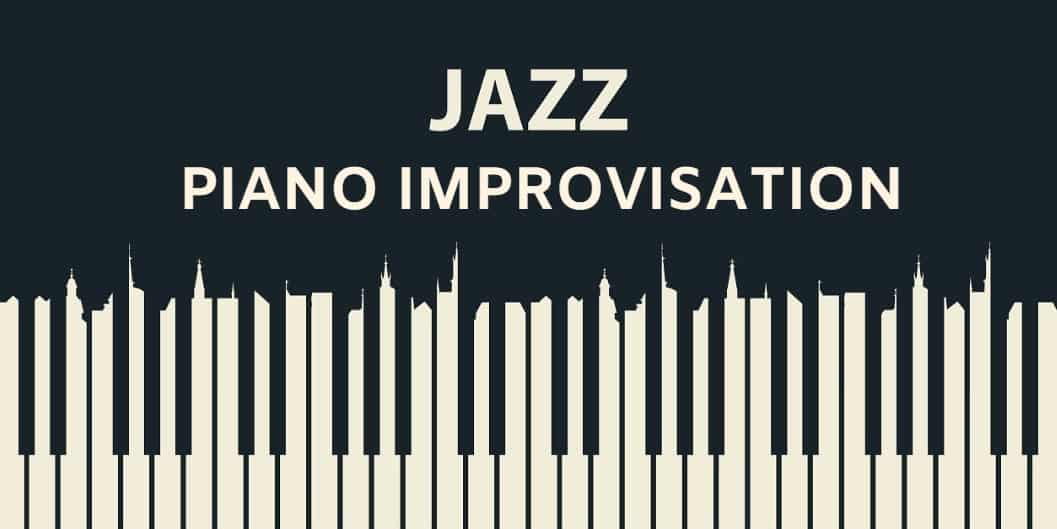
I clearly remember first hearing a piece of jazz music as a young and curious child and wondering how this music was put together. I was even more surprised to discover that what these musicians were playing was not written down but made up on the spot, or improvised. This whole idea fascinated me and in many ways continues to do so as the craft and sheer creativity of many jazz artists is almost beyond comprehension. In this article, I am going to place jazz improvisation on the piano under the spotlight to attempt to explain some of the approaches to this mysterious art.
Jazz Piano Improvisation
There are many different approaches to jazz improvisation as there are different types of jazz. A Bebop jazz piano solo will differ considerably from a Dixieland solo or a Cool Jazz solo. What they do have in common is the starting material, or in other words, the tune.
The tune for many jazz pieces is in a 32 bar format that often includes an A section followed by a B section. The A is usually repeated giving a kind of ABA structure. Not all jazz songs confirm this but quite regularly this is a useful starting point to plot your way through jazz improvisation.
As you would expect the jazz song consists of a written melody and supporting harmony or chords. The majority of pieces are tonal, key-based, but there are more contemporary works that have stretched the harmonic framework to include aleatoric concepts and the use of atonal systems too. This can be prevalent in ‘Free Form’ Jazz that needs a whole article in its own right. As such I will limit my exploration to tonal ones.
For this type of jazz, the pianist will base their improvisation on the melody, harmony, and rhythms of the given song. This allows for a vast range of options when improvising and encompasses the simpler approach through to the advanced. One of the ways of beginning to improvise, if you have not tried it before, is to vary the rhythm of the original melody. This could be by extending or shortening notes in a bar or two that makes a subtle change but is a beginning to changing or developing the material.
Another approach can be to ‘fill in’ the notes of a tune that are ‘missing’. If for instance, you see a melody that rises from F to A to D, you could, if there’s time in the bar, add the notes in between and make a scale: F, G, B or Bb, C and D. What you are doing in effect is altering the given tune and creating one of your own. This is the start of improvisation.
This may appear a little simplistic at first but if you try this idea for an entire jazz song, you will soon discover that you are improvising. The next step is to carefully listen to what you are playing to hear if it makes harmonic sense. By this I mean do the notes of the melody that you have added sound good with the chords that accompany the tune? This in itself can be a rather subjective consideration as what you feel sounds good may not resonate with what others feel sounds good. As a very broad rule of thumb, if the notes of the tune are in the chord, they will work together. Keep in mind that this is an idea to try out and will not sound like Art Tatum or Oscar Peterson, but it provides a start.
It helps enormously to have a good working knowledge of keys and chords with their related scales and arpeggios to improvise confidently in jazz. Without this then it is likely that your improvisations will reach a stopping point beyond which it is difficult to know how to proceed. If you listen to some of the early piano players of the 1930s much of the improvisation orientated around the arpeggios of the original melody without significant deviation from the original chord patterns. This is a simplistic analysis but one that serves a purpose.
If you take a jazz classic like ‘Lullaby of Birdland’ by George Shearing, the opening four chords are F minor, Dm7, G7, and C. Whilst it would not sound wholly convincing just to fill the two bars with falling or rising arpeggios, it would work as a ‘new’ melody over the existing chords. Better still is to combine a scale with an arpeggio or try to ‘link’ one to the other to form a phrase.
There are other key factors to consider when improvising. Altering the rhythm of an existing tune can be effective as a starting point but so can changing or adding a rhythmic emphasis. Jazz piano playing like jazz as a genre is littered with rhythmic subtleties and ‘syncopation’. This in effect means drawing attention to a weaker beat of a bar by emphasising the rhythm.
An example would be to ‘accent’ the last quaver of the bar in a 4/4 time signature. By placing an accent on weaker beats pushes the melodic line forwards and to an extent blurs the more ordinary feel of a straight 4/4 time signature. If it is used to highlight a note that is just outside the chord pattern this can add interest to an improvisation.
Using ‘blues scales’ is common in many jazz piano solos. The blues scale has many forms but the most common involves flattening the 3rd, 5th and 7th notes of a major scale. These ‘blue’ notes give a jazzy feel to almost any improvisation but care must be taken not to overuse them or they lose their effect. What you frequently hear in the solos of Oscar Peterson are well-rehearsed blues riffs that can range from fast running blues scales two octaves apart in the hands, to rapidly descending chordal figurations. It takes great skill and a finely tuned ear to accomplish this but practising riffs or pre-existing figurations is a useful skill to acquire.
There is much more to improvisation on the piano including knowing how to ‘play the changes’ or mark out the chord changes with the improvised melody, chord substitutions, and scalic alternatives. You can try one of the most colourful chordal substitutions called the ‘tri-tone substitution’.
Instead of a C for instance, play an F#, or substitute an Ab for an E. Instead of simply playing the scale related to the chord that is given, play the scale a tone higher. The key is to listen to the great jazz pianists, study the available transcriptions, patiently practice your instrument and have fun.

A classical player’s overview of improvisation, perhaps. Certainly, in a few paragraphs, not a guide. A few interesting points.